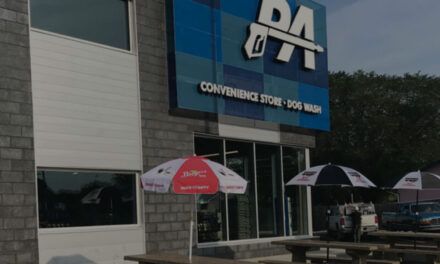
Why Should Businesses Care About Groundwater?

By Ann K. Ryan
When you live and work in North America – it’s easy to think water quality and water shortages aren’t something we need to worry about. After all, we’ve got thousands of lakes, and the Great Lakes alone account for 21 per cent of the world’s supply of surface fresh water and 84 per cent of North America’s supply.
Those statistics give people a false sense of security, and other numbers tell a more complete story. Only 2.5 per cent of the earth’s water is freshwater, and most of that is underground. Recent studies in the United States reveal that within 50 years many freshwater basins won’t be able to meet the U.S. water demand. Already, communities in some regions are facing critical shortages. According to the weekly U.S. Drought Monitor (USDM), as of Aug. 1, 2023, over 28 per cent of the contiguous United States was classified as experiencing moderate to exceptional (D1-D4) drought.
Essentially, that means the continent’s groundwater is being accessed faster than it is replenished by nature. All over North America – even in regions historically described as water-rich – the aquifers, porous rock and sediment that store massive amounts of water underground are being depleted.
Nearly 165 million Americans rely on groundwater for drinking water. That’s just under 50 per cent of the entire U.S. population. Environmental researchers at Canadian universities estimate that the number of Canadians depending on groundwater for drinking water has increased from 10 per cent to 30 per cent since 1970.
The reason behind the shortage of available clean water varies state by state and province by province. For instance, beyond drought, water shortages can be related to saltwater in coastal area aquifers, polluted shallow water in some regions and groundwater too deep to access in other regions. Taken together, these numbers lead to only one conclusion: Everyone needs to be invested in protecting our water resources, and that means that every water-related decision that businesses, communities, families and individuals make can matter.
Regulations move from underground storage to stormwater management
For decades, the problem of fuel leaking into groundwater from corroding steel tanks has been addressed by tight regulations and the introduction of fiberglass tanks for underground fuel storage. Subsequently, groundwater contamination caused by polluted wastewater came onto the radar of regulatory bodies, and a growing number of federal, regional, state and provincial regulations were put in place. In the case of water and wastewater storage applications, both structurally unstable plastic and deteriorating concrete structures were identified as potentially problematic for long-term secure storage.
Today, stormwater is on the other end of the regulatory spectrum. And again, the numbers tell the story. Changing weather patterns and growing urban populations add pressure to an already-aging infrastructure in both Canada and the United States. It is a trend projected to continue long into the future. With an estimated 70 per cent growth of urban population by 2050, the pressure is on for the hundreds of cities in need of new stormwater infrastructure.
The growing urbanization of North America is colliding with the aging infrastructure of cities to create a crisis in stormwater management. Unlike in rural landscapes, where rainwater soaks into the soil and replenishes groundwater supplies, in urban areas, rain falls on impervious surfaces, such as roofs, parking lots, and streets.
The U.S. Environmental Protection Agency (EPA) estimates that as much as 55 per cent of urban stormwater cannot soak into the ground. The resulting runoff collects trash, bacteria, heavy metals, pesticides, animal waste, and other pollutants before it flows into local infrastructure, where it can cause sewage overflows or move into rivers and streams. Today, approximately 30 per cent of pollutants in U.S. waterways are from untreated stormwater runoff.
Whichever the case, the result is the same: damage to public and private property, contaminated waterways (and aquatic life) and polluted groundwater, which is why environmental and regulatory agencies at all levels are aggressively increasing requirements for stormwater management and water quality.

The solution – like the problem – is underground
For business and property owners, the solution for underground storage of liquids is straightforward. Over the last 40 years, fiberglass has grown to be the number one material choice for underground storage of fuel products. Increasingly, fiberglass is also being recognized as a wise choice for underground storage of water and wastewater. The inherent corrosion resistance of fiberglass is a strong advantage when the stored liquid is corrosive, as in some wastewater applications, or toxic, as in some chemical applications.
When building new sites – or bringing older sites up to code – the owners and operators of carwashes, other automotive facilities and convenience stores must look beyond the conventionally recognized pollutants like oil and grease. They must also consider pollutants such as chlorine, nitrogen, phosphorous and heavy metals. That requires including products like grease interceptors, septic tanks and water reclaim tanks.
When it comes to stormwater management systems, underground storage is only part of the picture. While storage is essential to prevent flooding, coastal erosion and contamination of both groundwater and waterways, increasingly, regulatory agencies are including water-quality requirements. Depending on location, a system might require pretreatment, filtration and infiltration beyond basic retention and detention components.
In many sites, a water-quality function can easily be incorporated into a stormwater system. For instance, when a chamber system includes a main header row, it serves as a collection point for incoming runoff. With inlet pipes placed throughout the system, stormwater passes through the main header row into the main body of the chambers, and then filters into the soil and recharges an aquifer.. Capturing pollutants in a main header row provides the added benefit of improving water quality. Beyond that, it reduces maintenance costs and adds life to the system. Composite chambers have yet another benefit. Their structural strength allows for piping connections into the front, top or side of the chambers, which can eliminate the need for catch basins, manholes and manifold systems. This is both a space-saving and cost-saving feature.
By any measure – short-term or long-term, financial or environmental – the choice businesses, communities and individuals make today can make decades of difference.


Ann K. Ryan has written for international publications for more than 30 years, including major environmental and financial publications. She is a communications consultant for Mattr and specializes in writing about the technical aspects of sustainable products, including Xerxes and its HydroChain stormwater products.


































